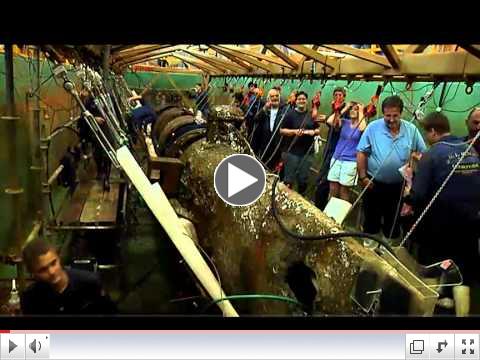|
February 2012
Issue No. Thirteen |
|
The H.L. Hunley is under restoration...
 | | The Hunley Moves Upright for First Time in Over a Century |
|
|
February Submarine Facts:
Unusual Hull Number:
02/02/1909 - Keel is laid for the USS G 1 (SS 19 1/2).
02/08/1911 - USS G 1 (SS 19 1/2) is launched.
Leap Day Events:
|
|
Submarine Reunions

USS Sunfish SSN649 and SS281
|
|
Friends....

|
|
Ahoy Shipmate!
Some may think that February, being in the dead of winter might be a slow month in the annals of submarine history but that is not the case. We are including a brief list of February submarine oddities and unusual events in this issue of PING.
Our team thinks you will find them very interesting; running the gamut from a submarine with a hull number of SS 19 1/2 , to gold bars being used for ballast. 2012 being a leap year, we have included some Leap Day events. In addition in honor of Presidents Day we listed some February presidential connections to the submarine force history.
This month's edition of Ping also includes a brief article about C.S. Hunley. While Hunley was, admittedly, not a United States submarine she was, nonetheless the first submarine to sink another warship in combat. That historic event occurred on 17 February 1864 and we again thought our readers might find it interesting.
Lastly, we are featuring two articles about famous submarine admirals who stepped down, albeit decades apart, in the month of February.
Enjoy and we look forward to seeing you soon!
Sincerely,
Mike Riegel
Executive Director
Submarine Force Library and Museum Association
|
|
H. L. HUNLEY - first submarine to sink a warship in combat, February 17, 1864

H.L. HUNLEY, a small, hand-powered submarine, was privately built at Mobile, Alabama, in 1863, based on plans furnished by Horace Lawson Hunley, James R. McClintock and Baxter Watson. Her construction was sponsored by Mr. Hunley and superintended by Confederate officers W.A. Alexander and G.E. Dixon.
H.L. HUNLEY was fashioned from a cylindrical iron steam boiler, which was deepened and also lengthened through the addition of tapered ends. HUNLEY was designed to be hand powered by a crew of nine: eight to turn the hand-cranked propeller and one to steer and direct the boat. As a true submarine, each end was equipped with ballast tanks that could be flooded by valves or pumped dry by hand pumps. Extra ballast was added through the use of iron weights bolted to the underside of the hull. In the event the submarine needed additional buoyancy to rise in an emergency, the iron weight could be removed by unscrewing the heads of the bolts from inside the vessel.
Click here to learn how the H.L. Henley sank, was raised then successfully sank a warship...
Admiral William F. "Red" Raborn
Steps Down

February 26, 1962 - Admiral W.F. "Red" Raborn steps down as Director of Special Projects. Under his direction, the Submarine Ballistic Missile Program became a reality and would become the strongest leg of the Nuclear Deterrence Triad. Raborn was a rear admiral when he was appointed, on 8 November 1955, as Director of Special Projects at the Bureau of Weapons. Appointed because of his reputation for getting along with people during stressful situations, Raborn's task was to develop a submarine-launched ballistic missile. He was told the new system had to achieve interim capability by early 1963 and full capability by early 1965. The USS GEORGE WASHINGTON (SSBN-598), the first ballistic missile submarine, was commissioned 30 December 1959, fired its first test missile 20 July 1960, and departed on the Navy's first deterrent patrol on 15 November 1960, five years ahead of schedule! For this significant accomplishment Admiral Raborn (ironically not a submariner, but a naval aviator) was awarded the Distinguished Service Medal.
Click here to get the details on this remarkable accomplishment
Admiral Hyman G. Rickover turns over Navy Nuclear Propulsion Directorate to Admiral McKee

February 01, 1982 - Admiral Kinnaird R. McKee replaces Admiral Hyman G. Rickover as director of the Navy Nuclear Propulsion Directorate. Admiral Rickover, born in Poland on 27 January 1900, just a few months before the American submarine force came into existence oversaw profound changes in, not only the submarine force, but also the entire Navy.
He graduated from the Naval Academy in 1922 and served on board USS LAVALLETTE and USS NEVADA until he returned to the Academy for postgraduate education in electrical engineering. Rickover underwent submarine training between January and June 1930, and went on to serve aboard the submarines USS S-9 (SS 114) and USS S-48 (SS 159). His service as head of the Bureau of Ships' Electrical Section during World War II brought him a Legion of Merit and provided him with experience in directing large development programs, choosing talented technical people, and working closely with private industry.
Assigned to the Bureau of Ships in September 1947, Rickover received training in nuclear power at Oak Ridge Tennessee and worked with the bureau to explore the possibility of nuclear-powered ship propulsion. In February 1949 he received assignment to the Division of Reactor Development at the U.S. Atomic Energy Commission and as Director of the Naval Reactors Branch in the Bureau of Ships. This twin role enabled him to lead the effort to develop the world's first nuclear-powered submarine, USS NAUTILUS (SSN 571), commissioned in January 1955. Promoted to the rank of Vice Admiral by 1958, Rickover exerted tremendous influence over the nuclear Navy in both engineering and cultural ways.
His views touched matters of design, propulsion, education, personnel, and professional standards. In every sense, he played the role of father to the nuclear fleet, its officers, and its men. After over sixty years of service to his country, under 13 presidents (Woodrow Wilson through Ronald Reagan), Rickover retired from the Navy in 1982.
|
|
|